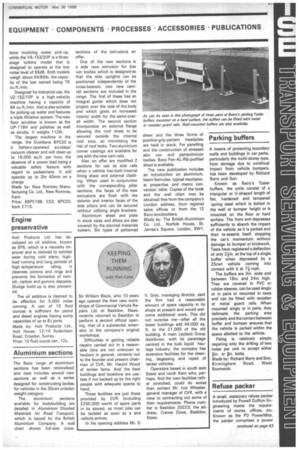Parking buffers
Page 63

If you've noticed an error in this article please click here to report it so we can fix it.
A means of protecting boundary walls and buildings in car parks, particularly the multi-storey type, from damage due to continual impact from vehicle bumpers, has been developed by Richard Berry and Son.
Known as Berry's Tosler buffers, the units consist of a triangular or U-shaped length of flat, hardened and tempered spring steel which is bolted to the wall at bumper height or is mounted on the floor or hard surface. The front arm depresses sufficiently to absorb the impact of the vehicle as it is parked and then re-asserts itself, stopping the car's momentum without damage to bumper or brickwork. Tests have registered a deflection of only 2+in. at the top of a single buffer when depressed by a 25cwt vehicle coming into contact with it at 7+ mph.
The buffers are 3in. wide and between 18in. and 24in. high. They are covered in PVC or rubber sleeves, can be used singly or in pairs or mounted in rows and can be fitted with wooden or metal guard rails. When mounted singly or in pairs, they delineate the parking area precisely and the contact between buffer and bumper ensures that the vehicle is parked within the space allotted to the vehicle.
Fixing is relatively simple requiring only the drilling of two holes per unit to accept either tin. or tin. bolts.
Made by: Richard Berry and Son, Birmingham Road, West B romwich.












































































































